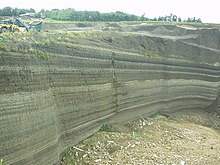Volcanic Eifel

The Volcanic Eifel or Vulkan Eifel (German: Vulkaneifel) is a region in the Eifel Mountains in Germany that is defined to a large extent by its volcanic geological history. Characteristic of this volcanic field are its typical explosion crater lakes or maars, and numerous other signs of volcanic activity such as volcanic tuffs, lava streams and volcanic craters like the Laacher See. The Volcanic Eifel is still volcanically active today. One sign of this activity is the escaping gases in the Laacher See.
Geographical location[]

The Volcanic Eifel stretches from the Rhine to the Wittlich Depression. It is bordered in the south and southwest by the South Eifel, in the west by Luxembourg and Belgian Ardennes and in the north by the North Eifel including the Hohes Venn. To the east the Rhine forms its geographical boundary, with no volcanicity immediately beyond it.
The Volcanic Eifel is divided into three natural regions:
- Volcanic West Eifel (Manderscheid, Daun, Gerolstein, Obere Kyll, Hillesheim (within the parish of Nohn),
- Volcanic High Eifel (Adenau, Kelberg, Ulmen and Nohn),
- Volcanic East Eifel (Brohltal, Vordereifel, Mendig, Pellenz)
The centre of the Volcanic Eifel is the region around Daun and Manderscheid and the areas within the Mayen-Koblenz district.
The landscape of the Volcanic Eifel is dominated by recent volcanism. Volcanic craters, thick pumice and basalt layers and maars create a diverse landscape that clearly witnesses to very recent events in geological terms.
The entire Volcanic Eifel covers an area of about 2,000 km2 (770 sq mi) and as of 2007 has a population of about 200,000.
Volcanoes[]
The following volcanoes belong to the Eifel, sorted by height in metres (m) above sea level (Normalhöhennull, NHN)[1]:
- Ernstberg (also: Erresberg), 699.9 m (2,300 ft), county of Vulkaneifel – west
- Scharteberg, 691.4 m (2,270 ft), county of Vulkaneifel; with the Eifel Transmitter (SWR) – west
- Prümscheid, 681 m (2,230 ft), county of Vulkaneifel – not volcanic (eponymous quartzite ridge; other summits being the Scharteberg and Dietzenley)
- Hochkelberg, 674.9 m (2,210 ft), county of Vulkaneifel; with a transmission mast on its south summit – Tertiary
- Nerother Kopf, 651.7 m (2,140 ft), county of Vulkaneifel; with the castle ruins of the – west
- Dietzenley, 617.6 m (2,030 ft), county of Vulkaneifel; with a wooden observation tower – west
- , approximately 590 m (1,940 ft), county of Vulkaneifel – Tertiary
- Hochsimmer, 587.9 m (1,930 ft), county of Mayen-Koblenz – east
- Gänsehals, 573.3 m (1,880 ft), county of Mayen-Koblenz – east
- , 575.1 m (1,890 ft), county of Ahrweiler (near Kempenich-Engeln) – east
- Hochstein, 563 m (1,850 ft), county of Mayen-Koblenz – east
- Steineberger Ley, 557.8 m (1,830 ft), county of Vulkaneifel; with a Volcano Information Platform (observation tower) – Tertiary
- Rockeskyller Kopf, 554.6 m (1,820 ft), county of Vulkaneifel – west
- Hoher List, 549.1 m (1,800 ft), county of Vulkaneifel; with the Hoher List Observatory – west
- , approximately 475 m (1,560 ft), county of Vulkaneifel (near Strohn) – west
- Veitskopf, 428.1 m (1,400 ft), county of Ahrweiler; near Laacher See; with an observation tower, the – east
- , 427.5 m (1,400 ft), county of Mayen-Koblenz (south of Ettringen) – east
- Karmelenberg, 372.5 m (1,220 ft), county of Mayen-Koblenz – east
- , 363.2 m (1,190 ft), county of Mayen-Koblenz (north of Mayen) – east
- , 295 m (970 ft), county of Mayen-Koblenz (near Kruft) – east
Laacher See[]
Of particular note is the volcanic caldera known as Laacher See, the site of an eruption around 12,900 years ago that had an estimated VEI of 6.
Geopark and museums[]
Future activity[]
There is thought that future eruptions may occur in the Eifel, as:[2][3]
- Each year the Eifel rises by about a millimetre.
- Geophysicists found that crust under the Eifel is thinner than most continental crust, suggesting that under the Eifel is a hot zone where magma is rising.
- Persistent small earthquakes and underground heating.
- Map of flood lake that may happen if the Rhine is blocked by a voluminous eruption in the Eifel
In 2020, Professor Kreemer noted that Eifel was the only region within an area of Europe studied where ground motion happened at significantly higher levels than expected.[4] It is possible that such movements originate from a rising magma plume.[4] This activity does not imply an immediate eruptive danger, but might suggest an increase in volcanic and seismic activity in the region.[4]
References[]
- ^ GeoViewer of the Federal Office of Geoscience and Resources (Bundesanstalt für Geowissenschaften und Rohstoffe)
- ^ Is there still volcanic activity in the Eifel?
- ^ Germany: a danger of volcanic eruptions?
- ^ Jump up to: a b c Kettley, Sebastian (11 June 2020). "Volcano warning: 'Something is brewing under Europe' Geologists make incredible discovery". Express. Retrieved 5 May 2021.
Further reading[]
- Werner P. D’hein: Vulkanland Eifel. Natur- und Kulturführer, mit 26 Stationen der „Deutschen Vulkanstraße“. Gaasterland Verlag, Düsseldorf 2006, ISBN 3-935873-15-8, ISBN 978-3-935873-15-4
- Wilhelm Meyer: Geologie der Eifel. Schweizerbart’sche Verlagsbuchhandlung, Stuttgart 1986. ISBN 3-510-65127-8
- Hans-Ulrich Schmincke (2000). Vulkanismus. Darmstadt: Wissenschaftliche Buchgesellschaft. ISBN 978-3-534-17471-3.
External links[]
| Wikimedia Commons has media related to Eifel. |
- Homepage of Vulkaneifel district
- German Volcanological Society
- "East Eifel Volcanic Field". Global Volcanism Program. Smithsonian Institution. Retrieved 2021-06-25.
- "West Eifel Volcanic Field". Global Volcanism Program. Smithsonian Institution. Retrieved 2021-06-25.
- Landscapes of Rhineland-Palatinate
- Pleistocene volcanism
- Volcanism of Germany
- Regions of the Eifel
- Global Geoparks Network members

